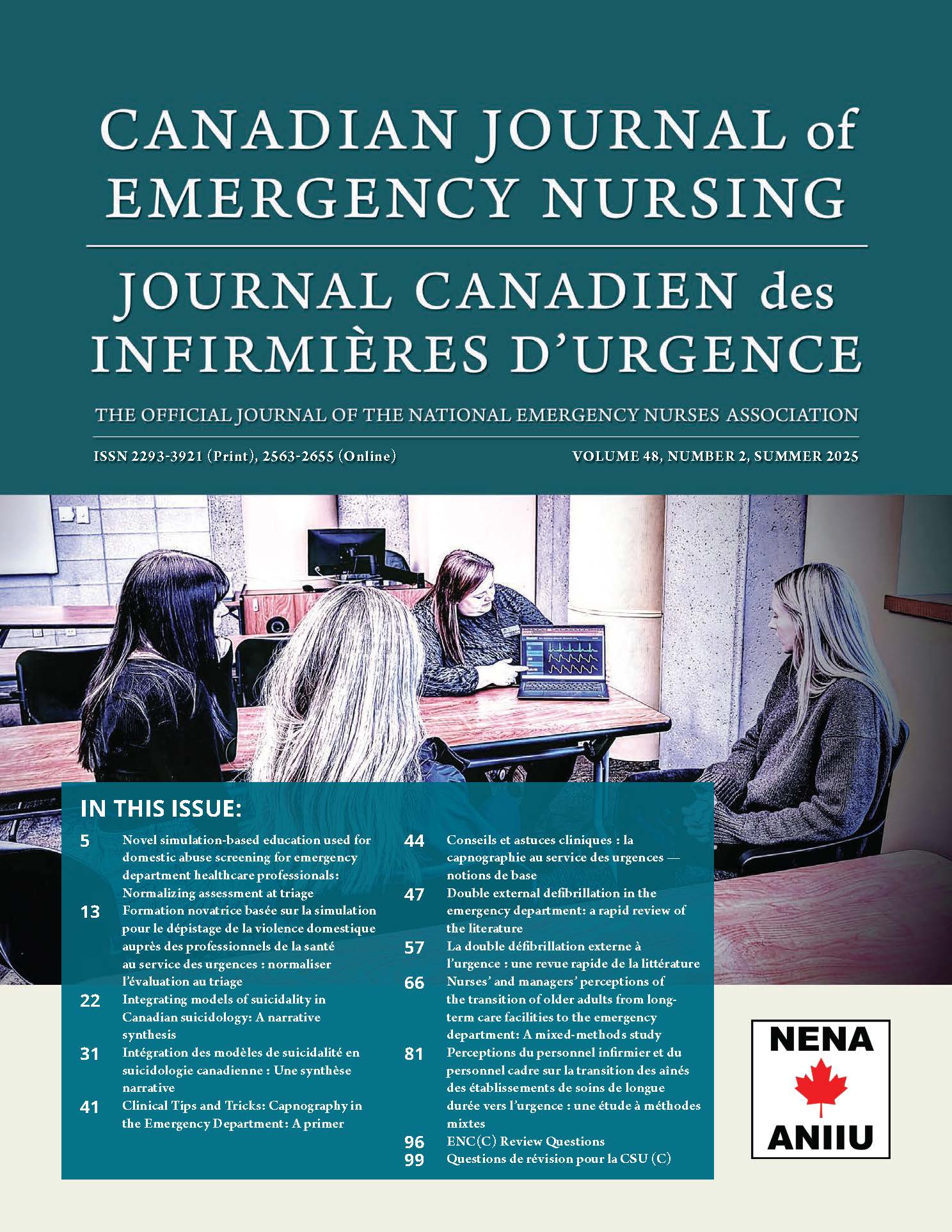Double (dual) sequential external defibrillation
A quick review of the literature
DOI:
https://doi.org/10.29173/cjen504Keywords:
Critical Care, resuscitation, defibrillation, Emergency nursingAbstract
Abstract:
Background The use of double external defibrillation (DED) in refractory cardiac arrest has been gaining increasing interest in recent years. Unlike traditional defibrillation, DED uses two defibrillators, either simultaneously or sequentially, to deliver shocks. This approach aims to maximize the probability of restoring normal heart rhythm when conventional techniques fail. While a number of studies have examined the use of DED in the pre-hospital setting, data on its use in the hospital setting, particularly in the emergency department, is significantly lacking. Objective: Synthesize current knowledge on the use of DED in hospital settings, focusing on reported practices and challenges arising from its implementation. Methods: A quick review of the literature was conducted, in accordance with the methodological recommendations of the Cochrane Rapid Review Working Group (Garritty et al., 2024). Databases consulted included PubMed, MEDLINE, EMBASE, CINAHL and the Cochrane Library. Results: The initial search identified 356 articles published between 2004 and 2024. Fifteen articles were selected, detailing 18 case reports. Analysis of the cases helped to identify the potential benefits, limitations and risks associated with the use of DED in a hospital setting. Conclusion: DED is generally used as a last resort, after traditional methods have failed. At present, the limited robustness of available studies does not allow us to establish its efficacy in comparison to simple defibrillation. Thus, randomized controlled trials are required to confirm its efficacy. For future practice, the uniqueness of clinical cases must be taken into account, and healthcare teams must consider a risk-benefit analysis for prolonged resuscitation. Standardization of procedures will also be essential to ensure optimal use of DED.
References
Aymond, J. D., Sanchez, A. M., Castine, M. R., Bernard, M. L., Khatib, S., Hiltbold, A. E., Polin, G. M., Rogers, P. A., Dominic, P. S., Velasco-Gonzalez, C., & Morin, D. P. (2024). Dual vs Single Cardioversion of Atrial Fibrillation in Patients with Obesity: A Randomized Clinical Trial. JAMA cardiology, 9(7), 641–648. https://doi.org/10.1001/jamacardio.2024.1091
Bell CR, Szulewski A, & Brooks SC. (2018). Make it two : A case report of dual sequential external defibrillation. CJEM, 20(5), 792‑797. https://doi.org/10.1017/cem.2017.42
Bergin, A., Blackburn, C., Chong, E., & Gupta, A. (2024). A case report of successful dual external defibrillation in cardiac arrest. New Zealand Medical Journal, 137(1595), 99‑101. https://doi.org/10.26635/6965.6479
Bignucolo, A., Parent, A., Dube, M., Kusnierczyk, J., Ansell, D., & Ohle, R. (2019). Triple-sequential defibrillation for refractory ventricular fibrillation in a 24-year-old male out of hospital cardiac arrest. Canadian Journal of Emergency Medicine, 21(6), 809‑811. https://doi.org/10.1017/cem.2019.415
Cheskes, S., Drennan, I. R., Turner, L., Pandit, S. V., & Dorian, P. (2024). The impact of alternate defibrillation strategies on shock-refractory and recurrent ventricular fibrillation : A secondary analysis of the DOSE VF cluster randomized controlled trial. Resuscitation, 198, 110186. https://doi.org/10.1016/j.resuscitation.2024.110186
Cheskes, S., Verbeek, P. R., Drennan, I. R., McLeod, S. L., Turner, L., Pinto, R., Feldman, M., Davis, M., Vaillancourt, C., Morrison, L. J., Dorian, P., & Scales, D. C. (2022). Defibrillation Strategies for Refractory Ventricular Fibrillation. New England Journal of Medicine, 387(21), 1947‑1956. https://doi.org/10.1056/NEJMoa2207304
Cheskes, S., Dorian, P., Feldman, M., McLeod, S., Scales, D. C., Pinto, R., Turner, L., Morrison, L. J., Drennan, I. R., & Verbeek, P. R. (2020). Double sequential external defibrillation for refractory ventricular fibrillation: The DOSE VF pilot randomized controlled trial. Resuscitation, 150, 178–184. https://doi.org/10.1016/j.resuscitation.2020.02.010
Choi, H. J., & Noh, H. (2021). Successful defibrillation using double sequence defibrillation : Case reports. Medicine (United States), 100(10), E24992. https://doi.org/10.1097/MD.0000000000024992
Clemency, B. M., Pastwik, B., & Gillen, D. (2019). Double sequential defibrillation and the tyranny of the case study. The American journal of emergency medicine, 37(4), 792‑793. https://doi.org/10.1016/j.ajem.2018.09.002
Deakin, C. D., Morley, P., Soar, J., & Drennan, I. R. (2020). Double (dual) sequential defibrillation for refractory ventricular fibrillation cardiac arrest : A systematic review. Resuscitation, 155, 24‑31. https://doi.org/10.1016/j.resuscitation.2020.06.008
Delorenzo, A., Nehme, Z., Yates, J., Bernard, S., & Smith, K. (2019). Double sequential external defibrillation for refractory ventricular fibrillation out-of-hospital cardiac arrest : A systematic review and meta-analysis. Resuscitation, 135, 124‑129. https://doi.org/10.1016/j.resuscitation.2018.10.025
Drennan, I. R., Seidler, D., & Cheskes, S. (2022). A survey of the incidence of defibrillator damage during double sequential external defibrillation for refractory ventricular fibrillation. Resuscitation plus, 11, 100287. https://doi.org/10.1016/j.resplu.2022.100287
El Tawil, C., Mrad, S., & Khishfe, B. F. (2017). Double sequential defibrillation for refractory ventricular fibrillation. American Journal of Emergency Medicine, 35(12), e3‑e4. https://doi.org/10.1016/j.ajem.2017.09.009
Fender, E., Tripuraneni, A., & Henrikson, C. A. (2013). Dual defibrillation for refractory ventricular fibrillation in a patient with a left ventricular assist device. The Journal of heart and lung transplantation : the official publication of the International Society for Heart Transplantation, 32(11), 1144‑1145. https://doi.org/10.1016/j.healun.2013.07.006
Frye, K. L., Adewale, A., Kennedy, E., & O’Grady, L. (2018). Beyond Advanced Cardiac Life Support : Dual-sequential Defibrillation for Refractory Ventricular Fibrillation after Witnessed Cardiac Arrest in the Emergency Department. Cureus. https://doi.org/10.7759/cureus.3717
Garritty, C., Hamel, C., Trivella, M., Gartlehner, G., Nussbaumer-Streit, B., Devane, D., Kamel, C., Griebler, U., & King, V. J. (2024). Updated recommendations for the Cochrane rapid review methods guidance for rapid reviews of effectiveness. BMJ, e076335. https://doi.org/10.1136/bmj-2023-076335
Gerstein, N. S., Shah, M. B., & Jorgensen, K. M. (2015). Simultaneous Use of Two Defibrillators for the Conversion of Refractory Ventricular Fibrillation. Journal of Cardiothoracic and Vascular Anesthesia, 29(2), 421‑424. https://doi.org/10.1053/j.jvca.2013.10.016
Hajjar, K., Berbari, I., El Tawil, C., Bou Chebl, R., & Abou Dagher, G. (2018). Dual defibrillation in patients with refractory ventricular fibrillation. American Journal of Emergency Medicine, 36(8), 1474‑1479. https://doi.org/10.1016/j.ajem.2018.04.060
Holmén, J., Hollenberg, J., Claesson, A., Herrera, M. J., Azeli, Y., Herlitz, J., & Axelsson, C. (2017). Survival in ventricular fibrillation with emphasis on the number of defibrillations in relation to other factors at resuscitation. Resuscitation, 113, 33‑38. https://doi.org/10.1016/j.resuscitation.2017.01.006
Hwang, C. W., Gamble, G., Marchick, M., & Becker, T. K. (2019). A case of refractory ventricular fibrillation successfully treated with low-dose esmolol. BMJ Case Reports, 12(3), 1‑5. https://doi.org/10.1136/bcr-2018-228208
Johnson, E. E., Alferness, C. A., Wolf, P. D., Smith, W. M., & Ideker, R. E. (1992). Effect of pulse separation between two sequential biphasic shocks given over different lead configurations on ventricular defibrillation efficacy. Circulation, 85(6), 2267‑2274. https://doi.org/10.1161/01.CIR.85.6.2267
Li, Y., He, X., Li, Z., Li, D., Yuan, X., & Yang, J. (2022). Double sequential external defibrillation versus standard defibrillation in refractory ventricular fibrillation : A systematic review and meta-analysis. Frontiers in Cardiovascular Medicine, 9, 1017935. https://doi.org/10.3389/fcvm.2022.1017935
Lin, N.-S., Lin, Y.-Y., Kao, Y.-H., Chuu, C.-P., Wu, K.-A., Chan, J.-S., & Hsiao, P.-J. (2022). Combination of Multidisciplinary Therapies Successfully Treated Refractory Ventricular Arrhythmia in a STEMI Patient : Case Report and Literature Review. Healthcare, 10(3), 507. https://doi.org/10.3390/healthcare10030507
Lybeck, A. M., Moy, H. P., & Tan, D. K. (2015). Double Sequential Defibrillation for Refractory Ventricular Fibrillation : A Case Report. Prehospital Emergency Care, 19(4), 554‑557. https://doi.org/10.3109/10903127.2015.1025155
Mohamed, A. K., Nayaz, M. S., Nawaz, A., & Kapadia, C. B. (2023). Keep shocking : Double sequential defibrillation for refractory ventricular fibrillation. The American journal of emergency medicine, 63, 178.e5-178.e6. https://doi.org/10.1016/j.ajem.2022.09.036
Nazir, H., Di Vita, M., Tyagi, N., Spiegel, R., Cohen, M., & Merlin, M. (2016). Why stop at 360J for refractory ventricular fibrillation? Chest, 150(4), 101A. https://doi.org/10.1016/j.chest.2016.08.109
Okubo, M., Komukai, S., Andersen, L. W., Berg, R. A., Kurz, M. C., Morrison, L. J., & Callaway, C. W. (2024). Duration of cardiopulmonary resuscitation and outcomes for adults with in-hospital cardiac arrest : Retrospective cohort study. BMJ, e076019. https://doi.org/10.1136/bmj-2023-076019
Pourmand, A., Galvis, J., & Yamane, D. (2018). The controversial role of dual sequential defibrillation in shockable cardiac arrest. American Journal of Emergency Medicine, 36(9), 1674‑1679. https://doi.org/10.1016/j.ajem.2018.05.078
Ross, E. M., Redman, T. T., Harper, S. A., Mapp, J. G., Wampler, D. A., & Miramontes, D. A. (2016). Dual defibrillation in out-of-hospital cardiac arrest : A retrospective cohort analysis. Resuscitation, 106, 14‑17. https://doi.org/10.1016/j.resuscitation.2016.06.011
Sena, R. C., Eldrich, S., Pescatore, R. M., Mazzarelli, A., & Byrne, R. G. (2016). Refractory Ventricular Fibrillation Successfully Cardioverted With Dual Sequential Defibrillation. The Journal of emergency medicine, 51(3), e37‑e40. https://doi.org/10.1016/j.jemermed.2016.05.024
Sood, J., & Kumar, M. (2024). Cardiopulmonary Resuscitation–Recent Advances and Role of Double Sequential External Defibrillator. Journal of Resuscitation, 1(1), 25-37.
Stiell, I. G., Walker, R. G., Nesbitt, L. P., Chapman, F. W., Cousineau, D., Christenson, J., Bradford, P., Sookram, S., Berringer, R., Lank, P., & Wells, G. A. (2007). BIPHASIC Trial : A Randomized Comparison of Fixed Lower Versus Escalating Higher Energy Levels for Defibrillation in Out-of-Hospital Cardiac Arrest. Circulation, 115(12), 1511‑1517. https://doi.org/10.1161/CIRCULATIONAHA.106.648204
van Diepen, S., Le May, M. R., Alfaro, P., Goldfarb, M. J., Luk, A., Mathew, R., Peretz-Larochelle, M., Rayner-Hartley, E., Russo, J. J., Senaratne, J. M., Ainsworth, C., Belley-Côté, E., Fordyce, C. B., Kromm, J., Overgaard, C. B., Schnell, G., & Wong, G. C. (2024). Canadian Cardiovascular Society/Canadian Cardiovascular Critical Care Society/Canadian Association of Interventional Cardiology Clinical Practice Update on Optimal Post Cardiac Arrest and Refractory Cardiac Arrest Patient Care. The Canadian journal of cardiology, 40(4), 524‑539. https://doi.org/10.1016/j.cjca.2024.01.012
Zuluaga, J. J., Caputi, R., & Yegneswaran, B. (2019). A case serie of double sequential defibrillation for refractory ventricular fibrillation. CHEST, 156, A386‑A386. https://doi.org/10.1016/j.chest.2019.08.423
Downloads
Published
How to Cite
Issue
Section
License
Copyright (c) 2025 William Tessier, Sabrina Blais, Josiane Provost, Simon Ouellet

This work is licensed under a Creative Commons Attribution 4.0 International License.
The Canadian Journal of Emergency Nursing is published Open Access under a Creative Commons CC-BY 4.0 license. Authors retain full copyright.




